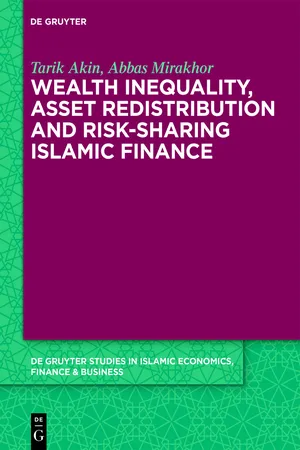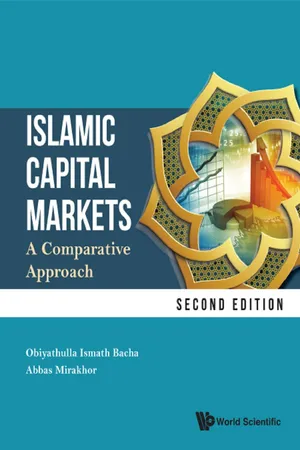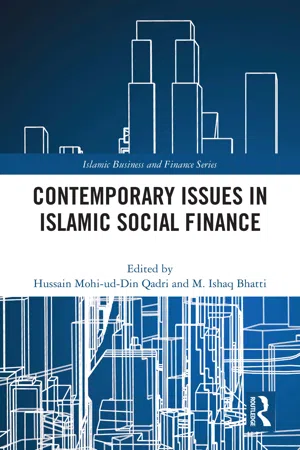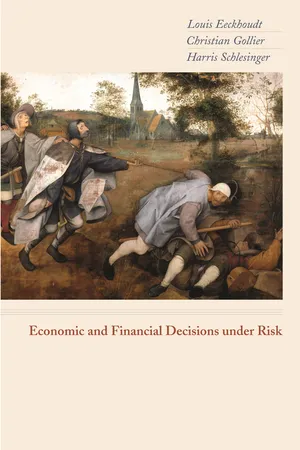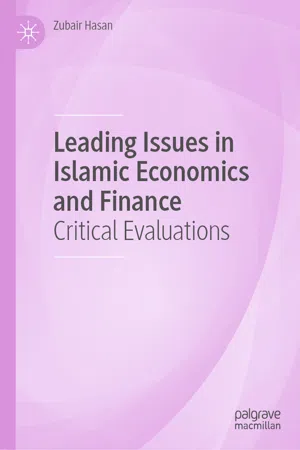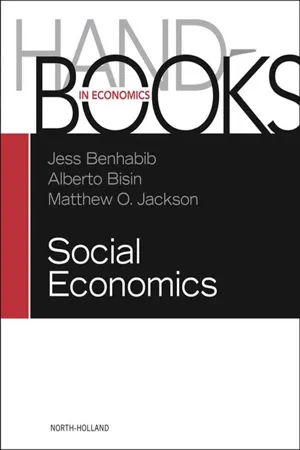Economics
Risk Sharing
Risk sharing refers to the practice of spreading the potential losses associated with a risk among multiple parties. In economics, risk sharing can occur through various mechanisms such as insurance, financial markets, and contracts. By sharing the risk, individuals or organizations can reduce their exposure to potential financial losses, leading to greater stability and security.
Written by Perlego with AI-assistance
Related key terms
Related key terms
1 of 4
Related key terms
1 of 3
9 Key excerpts on "Risk Sharing"
- Tarik Akin, Abbas Mirakhor(Authors)
- 2019(Publication Date)
- De Gruyter Oldenbourg(Publisher)
28The Arrow-Debreu-Hahn general equilibrium models, which are discussed in Chapter 3.5.3, are the risk-sharing conceptualizations in which contingent claims are shared concomitant to the risk bearing ability of the economic agents. Hence, risk-sharing contracts have the advantage of working through and within market forces and not against them (Bacha and Mirakhor 2013 , 270). Moreover, Mirakhor and Bao (2013 , 54) highlight thatequity share claims represent first-best instruments of Risk Sharing and satisfy characteristics required of Arrow Securities. It would appear that had the financial markets in industrial countries developed their financial sector along the lines suggested by the Arrow-Debreu-Hahn model, they could have had much more efficient Risk Sharing, and perhaps avoided the crises that have plagued the conventional financial system.Within the context of economics of inequality, the risk-sharing mechanisms provide shared prosperity through several channels. Maybe the most important contribution of the risk-sharing mechanisms is its role in mitigating the pro-cyclicality in financial system. This contribution is pertinently related to the inequality-financial crises nexus explained in the previous section. In theory, one of the main roles of the financial system is to mitigate shocks emanating from fluctuations in economic cycle. In effect, such a system produces counter-cyclicality between the financial and economic cycles. However, the reverse (pro-cyclicality) is the norm and intrinsic to the financial system mostly due to the co-movements between economic activity and credit growth, as well as, liquidity and expectation shocks to the banking system (Rochet 2008 , 96). As underlined by Mian (2013 , sec. 2) the fundamental driver of financial recessions is a failure of risk-sharing. He also argues that the workhorse macroeconomic models assume that households can shield themselves against asset price shocks, this is proven false in the real-world data, though (Mian 2013 , 1). Against the debt-based system, risk-sharing system render the financial system counter-cycle due to its inherent nature that the returns depend on contingent realizations (Askari et al. 2010- eBook - ePub
Islamic Capital Markets
A Comparative Approach
- Obiyathulla Ismath Bacha, Abbas Mirakhor(Authors)
- 2019(Publication Date)
- WSPC(Publisher)
It was explained, also in Chapter 1, that Risk Sharing is the operational essence of Islamic finance. Experience has shown that market capitalism, left to itself, fails in actuality to manage certain types of risk, e.g., risk to the livelihood of people and catastrophic risks. This is a violation of one of the major assumptions of neoclassical model of Arrow and his colleagues, that of complete markets. Additionally, much of financial transactions in contemporary market capitalism relies on risk transfer or risk shifting rather than Risk Sharing. As a consequence, it becomes necessary for governments to step in and correct these “market failures”. 14.1.1. Collective Risk Sharing As mentioned in Chapter 1, people face two types of market risk: (1) systematic (aggregate risk, or undiversifiable risk) and (2) unsystematic (idiosyncratic risk, specific risk, residual risk, diversifiable risk). The first relates to risk that is posed by general economic conditions dependent on macroeconomic factors such as growth of the economy, fiscal and monetary policies, interest rates, and inflation. Such risks are undiversifiable and therefore uninsurable. However, sound macroeconomic policies that strengthen economic fundamentals, effective international policy coordination, and the stability of the domestic and financial system can mitigate such risks to a significant degree. Unsystematic risk (or idiosyncratic risk), on the other hand, relates to risks that are specific to individuals or firms, such as unforeseen shocks to household income or firm’s profits. Such risks are diversifiable, and therefore, insurable. High correlation between consumption and an individual’s employment income means that sickness, accidents, and lay-offs all pose idiosyncratic risks that can be mitigated through risk-sharing arrangements that reduce dependence on wages as the only source of income, thus weakening the correlation between income and consumption - eBook - ePub
Public Finance and Islamic Capital Markets
Theory and Application
- Syed Aun R. Rizvi, Obiyathulla I. Bacha, Abbas Mirakhor(Authors)
- 2016(Publication Date)
- Palgrave Macmillan(Publisher)
These lead to the now infamous debt crises and were the prime cause of the 2008 financial meltdown. The argument for Risk Sharing falls under the rational belief that in an economy where the primary role of capital is to finance real sector activities, the rate of return to financial assets must be derived from the rate of return to the real sector. Thus it resolves asset liability mismatches and leads to the financial sector being synchronized closely with the real sector. A Risk Sharing economy has been envisaged as a system where the real sector is coupled with the financial sector in a manner where any fluctuation in the prices in real sector are reflected truly in the value of financial assets. It has been argued and theorized by Askari et al. (2012) that the boon of the modern day financial system’s fragility is the predominance of interest-based debt. The alternative is a financial system based on the notion of risk, instead of the risk transfer or risk shifting that characterizes contemporary finance. The economic system based on the premise of Risk Sharing mechanisms at all strata of the economic order propels us towards a system which is in line with Islamic ideology. This economic system will classify the financial arm of the order to its true purpose as the facilitator of real sector activities. What this true classification entails in a Risk Sharing system is a natural avoidance of the possibility of the Tobin-coined term “paper economy” (Tobin 1984). In a paper economy, the capital in the system is fictitious to a great extent, as a major bulk of financial transactions involve money today for more money tomorrow without facilitating value added in the real sector of the economy, leading to a decoupling of finance from the real sector of the economy. What the Risk Sharing economic system brings to the table is a unique proposition where the risks of adding value to the economy are shared between finance and production - eBook - ePub
Challenges in Economic and Financial Policy Formulation
An Islamic Perspective
- H. Askari, Z. Iqbal, A. Mirakhor(Authors)
- 2014(Publication Date)
- Palgrave Macmillan(Publisher)
Empirical studies broadly suggest that in low-income countries, saving, borrowing, the use of buffer stock, working longer hours or taking a second job, gift exchange, and private transfer of cash and clothing are some of the mechanisms used in Risk Sharing (Cox, 1998; Cox and Jimenez, 1997; Deaton, 1992; Kipnis, 1997; Kochar, 1999; Lim and Townsend, 1998). The degrees to which any economy can absorb shocks and cope with its consequences depend on available domestic and international risk-sharing mechanisms. One of the most important arguments advanced in favor of globalization was that improved Risk Sharing would bring people across the world closer, to create a “global village.” On theoretical grounds, expecting a much greater degree of Risk Sharing between and among economies—resulting from greater freedom of movement of resources, the advent of technological advances, and information super highways and advances in financial innovation—was realistic. After all, these advances would have meant progress toward market completion—a condition of optimal Risk Sharing posited in Arrow’s conception; or, at least, progress could be expected toward the design and widespread use of Arrow Securities, that is, those whose pay-offs were contingent upon the performance of the underlying asset, for example, equity-based securities with close links to the real. Much of the progress in information technology and economic liberalization, however, led to the development and innovation of risk-shifting and risk-transfer instruments with increasingly more tenuous relation to the real sector and the almost complete decoupling of financial and real sector developments (Epstein, 2006; Menkoff and Tolkorof, 2001; Mirakhor, 2010). The perception that globalization has not improved international Risk Sharing, despite considerable potential welfare gains, is supported by voluminous research (Baxter and Jermann, 1997; Imbs, 2006; Lee and Shin, 2008; Tesar, 1995; van Wincoop, 1999) - eBook - ePub
- Hussain Mohi-ud-Din Qadri, M. Ishaq Bhatti, Hussain Mohi-ud-Din Qadri, M. Ishaq Bhatti(Authors)
- 2021(Publication Date)
- Routledge(Publisher)
4 Risk management and Risk Sharing in Islamic finance Theory and practice Rodney WilsonDOI: 10.4324/9781003050209-44.1 Introduction
Risk Sharing is an essential characteristic of Islamic finance, as it is integral to the moral principle of bearing each other’s burden.1 It implies social solidarity rather than the pursuit of selfish individualistic gain at the expense of others. Risk cannot be avoided as it is inherent in economic and commercial relations and business cycles have always occurred; indeed, they were identified by the great Muslim philosopher of history Ibn Khaldun in the 15th century. He studied the causes of the rise and fall of all great empires with the upswing associated with strong moral leadership and law and order, creating firm foundations for economic expansion. In contrast, the downturn was characterised by corrupt governance and uncertainty.2 While businesses cannot isolate themselves from these macroeconomic developments, Risk Sharing can help mitigate some of the negative effects.The techniques of risk management aim to ensure that debt is sustainable and that clients can meet their financial commitments ensuring that financial institutions do not have to write down the value of their assets. There are many techniques for risk management, the most popular being credit scoring, which takes account of the income, existing debts and assets of the client.3 Risk management can facilitate Risk Sharing as an objective quantification of the ability of the client to take on debt lowers risk for both parties. Nevertheless, there are negative implications of credit scoring, with those on low and volatile income and few, if any, assets classified as unfit to benefit from commercial financing. In other words they may face financial exclusion, while those with high incomes with substantial assets are prioritised to receive financial backing.4 - eBook - ePub
Risk-Sharing Finance
An Islamic Jurisprudence (Fiqh) Perspective
- Saad Bakkali, Abbas Mirakhor(Authors)
- 2021(Publication Date)
- De Gruyter Oldenbourg(Publisher)
For al-Bay’ that is built on justice and formed on the basis of property rights, the mechanisms of exchange in this system are done through the basis of Risk Sharing. As defined earlier, Risk Sharing is the result of applying such a system. The parameters that result in Risk Sharing are the ability and willingness to share the risk. The centrality of risk in this concept is evident. The concept and founding pillars of Risk Sharing will be further explained.3.1 Risk and Shari’ah Treatment
Risk emerges from two sources; uncertainty and ambiguity. Uncertainty and ambiguity give rise to the discomfort experienced in thinking about any missing information with regard to either outcomes or probabilities.3 This discomfort can be resulted from the unknown future outcomes or the behavior of the counterparty.4Risk can be defined as the uncertainty and ambiguity of meeting the contracting parties’ expectations. It is beyond what is commonly perceived as the probability of loss, as the contract of wadi’ah (selling at discount) implies that the seller expects to lose a certain amount given as a discount to the buyer. However, this expected “loss” cannot be viewed as risk as it is expected by the seller who is willing to bear it for certain reasons. The risk in this case is that there is the possibility that the seller can lose more than expected, which is something that is not directly related to the contractual arrangement and is based on market conditions.Shari’ah recognizes the problem of uncertainty. Shari’ah has also introduced solutions to the two types of risk (uncertainty and ambiguity). The effect of ambiguity; for example, is reduced and managed by having precise contracts that govern the behavior of the parties in the transaction. A contract acts as a constitution for the parties who would refer to it in event that they face any kind of disputes. Allah in the Quran states: “O you who have believed, fulfill [all] contracts.” (Surah Al-Ma’idah, Verse 1) And in another Verse: “And fulfill [every] commitment. Indeed, the commitment is ever [that about which one will be] questioned.” (Surah al-Israe, Verse 34) The Hadith of the Prophet stated that: “And the Muslims will be held to their conditions (commitments), except the conditions that make the lawful unlawful, or the unlawful lawful.”5 Al- Bukhari narrated in his Sahih, the book of good manners, that the Prophet said: “The signs of a hypocrite are three: Whenever he speaks, he tells a lie; and whenever he promises, he breaks his promise; and whenever he is entrusted, he betrays (proves to be dishonest)”.6 Therefore, Shariah stresses that the contracting parties should keep their obligations as per the contract and they have to state their expectations and the outcomes of the contract very clearly. In addition, the contract has to clearly state the expected behavior of each one of the parties involved in the transaction and it is their responsibility to ensure that no ambiguity shall arise from or by the contract. It will be regarded as Gharar and cheating if the contract is not clear.7 - eBook - ePub
- Louis Eeckhoudt, Christian Gollier, Harris Schlesinger(Authors)
- 2011(Publication Date)
- Princeton University Press(Publisher)
Part III
Risk Sharing
Passage contains an image
10
Efficient Allocations of Risks
This chapter examines the efficient allocation of risk within an economy. Up to now, we have mostly considered individual decisions related to risk and time. In order to focus on the properties of the Risk Sharing itself, we will assume that there are no transaction costs associated with the transfer of risk. One can easily characterize efficient Risk Sharing in two particular exchange economies. In the first economy, an infinite number of risk-averse individuals bear an independent and identically distributed risk. Suppose that these individuals create a mutual agreement whereby everyone would transfer his own risk to the pool in exchange for the mean outcome. By the Law of Large Numbers, this arrangement is technically feasible. Furthermore, this outcome is obviously a Pareto-efficient allocation of risk: everyone exchanges a risky wealth for its mean, i.e. all risk-averse individuals are fully insured. Alternatively, consider an economy in which all risk-averse agents have the same attitude toward risk and where they bear the same perfectly correlated risk. In this economy there are no possible gains from Risk Sharing. Thus autarky is Pareto efficient, and it is a competitive allocation.More realistically, agents are not alike and individual risks are hopefully not perfectly correlated, but they are not completely idiosyncratic either. People are not completely alike, as they do not have the same wealth, and it is likely that there is some heterogeneity in their degree of risk aversion. In such a heterogenous economy, it is essential that agents be allowed to trade their risk. In this chapter, we describe the set of allocations that are Pareto efficient. We do not address the question of whether decentralized economies are able to attain such desirable allocations of risks. Whether such a market mechanism exists and how it works are topics left for the next chapter. - eBook - ePub
Leading Issues in Islamic Economics and Finance
Critical Evaluations
- Zubair Hasan(Author)
- 2020(Publication Date)
- Palgrave Macmillan(Publisher)
3 Also, the risk-profit linkage we referred to above cannot be shown delivering justice, one of the top priorities of Islamic finance; for, no one-on-one correspondence can be established between risk and profit because of uncertainty affecting both. Furthermore, the risk-profit linkage is but ex ante whereas, the negotiated sharing applies to a division of ex post profit; no risk is involved. Islam allows sharing of profit (loss) of which Risk Sharing is a consequence, not the cause.The contribution of Knight’s contextualization to Islamic finance is twofold. First, he provides a precise definition of what risk is and what it is not. In contrast, the proponents of basing Islamic finance solely on Risk Sharing never clarified what they meant by risk or what distinction they make between Risk Sharing and risk transfer? And, in what situation one of the two would hold well against the other?4 Is sharing or transfer of risk to be within the capitalist class or other factors in production should also be participating in sharing? It is such sort of issues that we shall address in the following sections.Second, Knight took note of the rise to dominance of modern corporations that has characteristically changed the risk-profit equation in businesses; especially finance. Capital, organization, and entrepreneurship have become distinctly separate entities with reference to their rewards. The bond between profit and risk-taking has much loosened. The appropriation of profit has long become non-functional, not governed by any theory; power is the arbiter. The proponents of Risk Sharing do not seem to have imbibed the ramifications of this change and its impact on the risk-reward equation.Box 12.1: Risk and Risk ManagementRisk is a psychic concept, i.e. it is ‘perceived’. It is difficult to measure. All risk cannot be measured. Components that can be measured have to be identified. These components, along with their probability measures and weightings have to be settled. If enough data on them can be gathered, it can form the basis of risk measurement framework. Still, technical risk analytics requires assumptions about underlying preferences—typically expressed through a utility function. Such analysis is usually used to:- Rationalize behaviour we observe
- Provide guidance/control over our own behaviour
- eBook - ePub
- Jess Benhabib, Alberto Bisin, Matthew O. Jackson(Authors)
- 2010(Publication Date)
- North Holland(Publisher)
Idiosyncratic risk generates potential gains from trade: risk averse individuals subject to independent sources of risk can increase their welfare by pooling risk. Many of the social welfare institutions that exist in developed economies today began some hundred years ago as mutual insurance societies against illness, death or unemployment. For covariate risk, mutual gains from trade arise whenever economic agents differ in their degree of risk aversion. In this case it is common for a risk neutral agent – e.g., a rich individual or a corporation – to insure risk averse individuals subject to common shocks.Risk Sharing between households can in principle be achieved through contracts enforceable by courts. This applies for instance to insurance contracts, joint liability contracts, and corporations, among others. Court enforcement is not always feasible, however. Courts may be absent or unreliable, or the arrangement may be unverifiable, illegal, or simply unprotected by law. Because of the contingent nature of mutual insurance arrangements, writing a complete contract allowing for all contingencies may be too time consuming or simply impossible. Furthermore, many transactions are too small to justify court action, or the parties too poor to recover anything in case of victory in court. This is particularly true in developing countries where many firms and market transactions are small and many people are too poor to be sued.In these circumstances the legal enforcement of Risk Sharing contracts is problematic even though the mutual gains may be large. Informal enforcement mechanisms become necessary. The literature has explored several mechanisms by which Risk Sharing between households can be sustained without reliance on the court system. Detailed discussions are provided in Platteau (1994a) , Platteau (1994b) , Fafchamps (1992) , and Cox and Fafchamps (2007) .One possibility is to rely on preferences and emotions, either directly in the form of altruism, or indirectly via social norms that are punished through guilt and shame. Another possibility is to rely on long-term strategic interaction among self-interested individuals. The first avenue has been explored in detail by psychologists, sociologists, and anthropologists, but has also received significant attention from economists. The second was initially put forth by anthropologists and sociologists and subsequently formalized by economists. In this section we present an overview of this literature, beginning with the repeated interaction approach.
Index pages curate the most relevant extracts from our library of academic textbooks. They’ve been created using an in-house natural language model (NLM), each adding context and meaning to key research topics.
Explore more topic indexes
Explore more topic indexes
1 of 6
Explore more topic indexes
1 of 4
